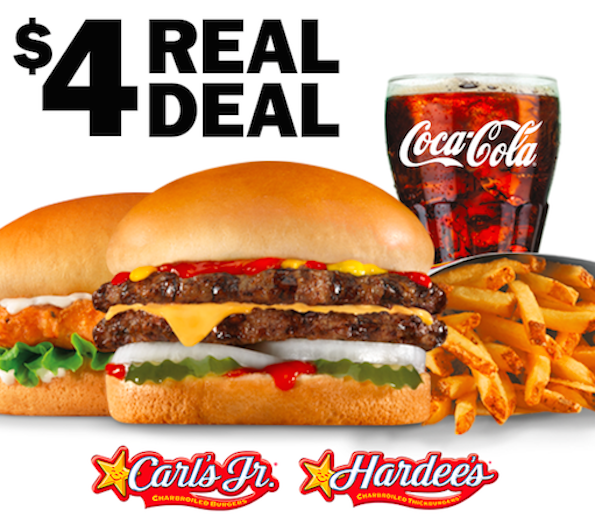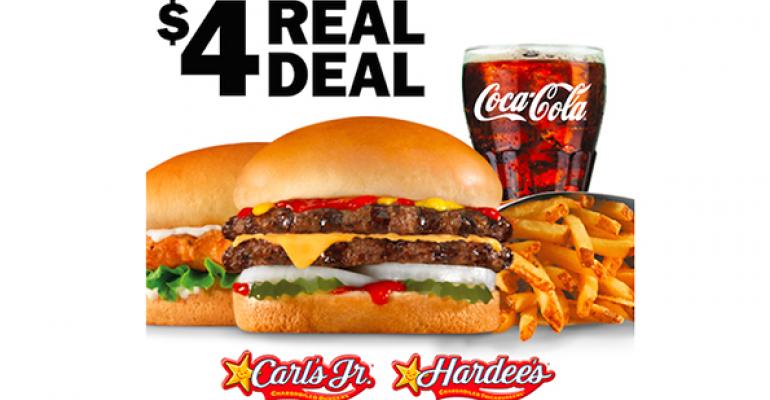 This post is part of the On the Margin blog.
This post is part of the On the Margin blog.
This morning, Hardee’s and Carl’s Jr. jumped on the food discounting bandwagon with its own 4-for-$4 deal.
The “$4 Real Deal” includes two sandwiches — the Double Cheeseburger and the Spicy Chicken Sandwich — plus fries and a drink for $4. “Just because something is cheap doesn’t mean it’s a great deal,” Brad Haley, chief marketing officer for Hardee’s and Carl’s, said in a statement.
Quick-service chains are engaging in a good bit of one-upmanship in what has become the latest iteration of the Burger Wars. Earlier this month, Burger King started offering a 5-for-$4 deal with a bacon cheeseburger, nuggets, fries, drink and a chocolate chip cookie.
These deals followed a 4-for-$4 deal from The Wendy’s Co. started last year, and then McDonald’s McPick 2-for-$2 menu unleashed this year.
That both Burger King and Hardee’s/Carl’s Jr. are jumping into the discounting fray is as good an indication that the discounting efforts are working as anything else. Why start discounting if you don’t have sales numbers showing lost business to your rivals?
 It’s long been clear that quick-service customers want discounts, and a certain percentage of them are promiscuous enough in their restaurant choices to search out the best food deals.
It’s long been clear that quick-service customers want discounts, and a certain percentage of them are promiscuous enough in their restaurant choices to search out the best food deals.
Chains that have shifted from discounting strategies have, in almost every case, lost sales or traffic as a result of such moves.
One possible exception was Denny’s, which has used a $2 $4 $6 $8 menu to good affect. Last year, it de-emphasized that menu and average check increased — but traffic did, too.
Still, McDonald’s, Subway and several other chains all saw evidence of lost traffic when they shifted away from value meals in recent years, and, as I’ve noted before, Steak 'n Shake proved that persistent discounts keep customers coming.
The big question is where these companies get the added business with all of these traffic-driving discounts — assuming that the chains aren’t cannibalizing their own traffic, or that they’re simply not trading customers among themselves.
In general, restaurants are a zero-sum game. There is little in the way of organic industry-wide traffic growth, even with gas prices low and unemployment on the decline. Traffic was flat last year, according to various restaurant sales indices, and few prognostications we’ve seen thus far predict much better for 2016.
To be sure, it’s possible that quick-service chains will take business from convenience stores and other non-restaurant companies that compete heavily on price and convenience.
It’s unlikely that Burger King and McDonald’s will take business from, say, Chipotle — though they may take some.
The most likely share donor is casual dining. Consumers have been reducing the number of times they dine at dine-in eateries for years, opting instead for convenience-oriented fare more often. That trend isn’t changing.
Consider recent comments from Brinker International Inc. Company-owned Chili’s locations saw a 4-percent traffic decline in the company’s fiscal second quarter ended Dec. 23. The company blamed, in part, problems in oil-rich states like Texas.
But we spoke with a quick-service franchisee in Texas who said he’s seen no such problems. While that’s hardly scientific, it suggests consumers even in hard-hit states are giving up a night at a restaurant for a quick, cheap and convenient bite.
As more of these discounts take hold, that shift of business from casual-dining to quick-service restaurants can only continue.
Contact Jonathan Maze at [email protected]
Follow him on Twitter at @jonathanmaze

